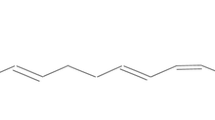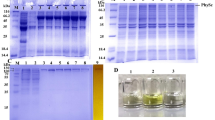Abstract
Our screening study yielded a copper amine oxidase (SrAOX) from Syncephalastrum racemosum, which showed much higher affinity and catalytic efficiency toward ethanolamine (EA) than any other amine oxidase (AOX). Following purification of the enzyme to electrophoretic homogeneity from a cell-free extract, the maximum activity toward EA was detected at pH 7.2–7.5 and 45 °C. The SrAOX complementary DNA (cDNA) was composed of a 2052-bp open reading frame encoding a 683-amino acid protein with a molecular mass of 77,162 Da. The enzyme functions as a homodimer. The deduced amino acid sequence of SrAOX showed 55.3 % identity to Rhizopus delemar AOX and contains two consensus sequences of Cu-AOX, NYDY, and HHQH, suggesting SrAOX is a type 1 Cu-AOX (i.e., a topaquinone enzyme). Structural homology modeling showed that residues 112ML113, 141FADTWG146 M158, and N318 are unique, and T144 possibly characterizes the substrate specificity of SrAOX. The recombinant enzyme (rSrAOX) was produced using Escherichia coli. Steady-state kinetic analysis of rSrAOX activity toward EA (pH 7.5 and 45 °C) gave K m and k cat values of 0.848 ± 0.009 mM and 9.11 ± 0.13 s−1, respectively. The standard curves were linear between 0.1 and 2 mM EA, and 10 μg mL−1–2.5 mg mL−1 (15 μM–3.6 mM) phosphatidylethanolamine using Streptomyces chromofuscus phospholipase D, respectively, was sufficiently sensitive for clinical use.







Similar content being viewed by others
References
Atkin KE, Reiss R, Koehler V, Bailey KR, Hart S, Turkenburg JP, Turner NJ, Brzozowski AM, Grogan G (2008a) The structure of monoamine oxidase from Aspergillus niger provides a molecular context for improvements in activity obtained by directed evolution. J Mol Biol 384:1218–1231
Atkin KE, Reiss R, Turner NJ, Brzozowski AM, Grogan G (2008b) Cloning, expression, purification, crystallization and preliminary X-ray diffraction analysis of variants of monoamine oxidase from Aspergillus niger. Acta Crystallogr Sect F: Struct Biol Cryst Commun 64:182–185
Azakami H, Yamashita M, Roh J-H, Suzuki H, Kumagai H, Murooka Y (1994) Nucleotide sequence of the gene for monoamine oxidase (maoA) from Escherichia coli. J Ferment Bioeng 77:315–319
Brazeau BJ, Johnson BJ, Wilmot CM (2004) Copper-containing amine oxidases. Biogenesis and catalysis; a structural perspective. Arch Biochem Biophys 428:22–31
Cai D, Williams NK, Klinman JP (1997) Effect of metal on 2,4,5-trihydroxyphenylalanine (topa) quinone biogenesis in the Hansenula polymorpha copper amine oxidase. J Biol Chem 272:19277–19281
Chang CM, Klema VJ, Johnson BJ, Mure M, Klinman JP, Wilmot CM (2010) Kinetic and structural analysis of substrate specificity in two copper amine oxidases from Hansenula polymorpha. Biochemistry 49:2540–2550
Elmore B, Bollinger J, Dooley D (2002) Human kidney diamine oxidase: heterologous expression, purification, and characterization. J Biol Inorg Chem 7:565–579. doi:10.1007/s00775-001-0331-1
Elovaara H, Kidron H, Parkash V, Nymalm Y, Bligt E, Ollikka P, Smith DJ, Pihlavisto M, Salmi M, Jalkanen S (2011) Identification of two imidazole binding sites and key residues for substrate specificity in human primary amine oxidase AOC3. Biochemistry 50:5507–5520
Flipphi M, Kocialkowska J, Felenbok B (2002) Characteristics of physiological inducers of the ethanol utilization (alc) pathway in Aspergillus nidulans. Biochem J 364:25–31
Foster A, Barnes N, Speight R, Keane MA (2012) Identification, functional expression and kinetic analysis of two primary amine oxidases from Rhodococcus opacus. J Mol Cat B: Enzym 74:73–82. doi:10.1016/j.molcatb.2011.09.001
Irvin RT, To M, Costerton JW (1984) Mechanism of adhesion of Alysiella bovis to glass surfaces. J Bacteriol 160:569–576
Jones PW, Turner JM (1984) Interrelationships between the enzymes of ethanolamine metabolism in Escherichia coli. J Gen Microbiol 130:299
Kim M, Okajima T, Kishishita S, Yoshimura M, Kawamori A, Tanizawa K, Yamaguchi H (2002) X-ray snapshots of quinone cofactor biogenesis in bacterial copper amine oxidase. Nat Struct Biol 9:591–596
Kishishita S, Okajima T, Kim M, Yamaguchi H, Hirota S, Suzuki S, Kuroda S, Tanizawa K, Mure M (2003) Role of copper ion in bacterial copper amine oxidase: spectroscopic and crystallographic studies of metal-substituted enzymes. J Am Chem Soc 125:1041–1055. doi:10.1021/ja017899k
Klema VJ, Solheid CJ, Klinman JP, Wilmot CM (2013) Structural analysis of aliphatic versus aromatic substrate specificity in a copper amine oxidase from Hansenula polymorpha. Biochemistry 52:2291–2301
Kulkarni A, Hodgson E (1973) Ethanolamine oxidase from the blowfly, Phormia regina (Diptera: Insecta). Comp Biochem Physiol B: Comp Biochem 44:407–422
Laemmli UK (1970) Cleavage of structural proteins during the assembly of the head of bacteriophage T4. Nature 227:680–685
Langley DB, Trambaiolo DM, Duff AP, Dooley DM, Freeman HC, Guss JM (2008) Complexes of the copper-containing amine oxidase from Arthrobacter globiformis with the inhibitors benzylhydrazine and tranylcypromine. Acta Crystallogr Sect F: Struct Biol Cryst Commun 64:577–583
Lee JI, Kim YW (2013) Characterization of amine oxidases from Arthrobacter aurescens and application for determination of biogenic amines. World J Microbiol Biotechnol 29:673–682. doi:10.1007/s11274-012-1223-y
Lüthy R, Bowie JU, Eisenberg D (1992) Assessment of protein models with three-dimensional profiles. Nature 356:83–85. doi:10.1038/356083a0
Matsuzaki R, Fukui T, Sato H, Ozaki Y, Tanizawa K (1994) Generation of the topa quinone cofactor in bacterial monoamine oxidase by cupric ion-dependent autooxidation of a specific tyrosyl residue. FEBS Lett 351:360–364. doi:10.1016/0014-5793(94)00884-1
McGrath AP, Mithieux SM, Collyer CA, Bakhuis JG, van den Berg M, Sein A, Heinz A, Schmelzer C, Weiss AS, Guss JM (2011) Structure and activity of Aspergillus nidulans copper amine oxidase. Biochemistry 50:5718–5730
Munk C, Lapidus A, Copeland A, Jando M, Mayilraj S, Glavina Del Rio T, Nolan M, Chen F, Lucas S, Tice H, Cheng JF, Han C, Detter JC, Bruce D, Goodwin L, Chain P, Pitluck S, Goker M, Ovchinikova G, Pati A, Ivanova N, Mavromatis K, Chen A, Palaniappan K, Land M, Hauser L, Chang YJ, Jeffries CD, Bristow J, Eisen JA, Markowitz V, Hugenholtz P, Kyrpides NC, Klenk HP (2009) Complete genome sequence of Stackebrandtia nassauensis type strain (LLR-40K-21). Stand Gen Sci 1:234–241. doi:10.4056/sigs.47643
Murakawa T, Hayashi H, Sunami T, Kurihara K, Tamada T, Kuroki R, Suzuki M, Tanizawa K, Okajima T (2013) High-resolution crystal structure of copper amine oxidase from Arthrobacter globiformis: assignment of bound diatomic molecules as O2. Acta Crystallogr Sect D 69:2483–2494. doi:10.1107/S0907444913023196
Murray JM, Saysell CG, Wilmot CM, Tambyrajah WS, Jaeger J, Knowles PF, Phillips SE, McPherson MJ (1999) The active site base controls cofactor reactivity in Escherichia coli amine oxidase: X-ray crystallographic studies with mutational variants. Biochemistry 38:8217–8227. doi:10.1021/bi9900469
O’Donnell K (1993) Fusarium and its near relatives. In: Reynolds D, Taylor J (eds) The fungal holomorph: mitotic, meiotic and pleomorphic speciation in fungal systematics. CAB International, Wallingford, pp 225–233
Okamura H, Murooka Y, Harada T (1976) Regulation of tyramine oxidase synthesis in Klebsiella aerogenes. J Bacteriol 127:24–31
Ota H, Tamezane H, Sasano Y, Hokazono E, Yasuda Y, Sakasegawa SI, Imamura S, Tamura T, Osawa S (2008) Enzymatic characterization of an amine oxidase from Arthrobacter sp. used to measure phosphatidylethanolamine. Biosci Biotechnol Biochem 72:2732–2738
Palenik B, Morel FMM (1991) Amine oxidases of marine phytoplankton. Appl Environ Microbiol 57:2440
Peter C, Laliberté J, Beaudoin J, Labbé S (2008) Copper distributed by Atx1 is available to copper amine oxidase 1 in Schizosaccharomyces pombe. Eukaryot Cell 7:1781–1794
Roh JH, Suzuki H, Azakami H, Yamashita M, Murooka Y, Kumagai H (1994) Purification, characterization, and crystallization of monoamine oxidase from Escherichia coli K-12. Biosci Biotechnol Biochem 58:1652–1656
Rosini E, Tonin F, Vasylieva N, Marinesco S, Pollegioni L (2014) Evolution of histamine oxidase activity for biotechnological applications. Appl Microbiol Biotechnol 98:739–748. doi:10.1007/s00253-013-5159-4
Sablin SO, Yankovskaya V, Bernard S, Cronin CN, Singer TP (1998) Isolation and characterization of an evolutionary precursor of human monoamine oxidases A and B. Eur J Biochem 253:270–279. doi:10.1046/j.1432-1327.1998.2530270.x
Šali A, Potterton L, Yuan F, van Vlijmen H, Karplus M (1995) Evaluation of comparative protein modeling by MODELLER proteins. Struct Funct Bioinf 23:318–326
Smith MA, Pirrat P, Pearson AR, Kurtis CR, Trinh CH, Gaule TG, Knowles PF, Phillips SE, McPherson MJ (2010) Exploring the roles of the metal ions in Escherichia coli copper amine oxidase. Biochemistry 49:1268–1280. doi:10.1021/bi901738k
Söding J (2005) Protein homology detection by HMM–HMM comparison. Bioinformatics 21:951–960
Sugimori D, Kano K, Matsumoto Y (2012) Purification, characterization, molecular cloning and extracellular production of a phospholipase A1 from Streptomyces albidoflavus NA297. FEBS Open Bio 2:318–327
Tanizawa K, Matsuzaki R, Shimizu E, Yorifuji T, Fukui T (1994) Cloning and sequencing of phenylethylamine oxidase from Arthrobacter globiformis and implication of Tyr-382 as the precursor to its covalently bound quinone cofactor. Biochem Biophys Res Commun 199:1096–1102
Wang S, Zhang S, Liou LC, Ren Q, Zhang Z, Caldwell GA, Caldwell KA, Witt SN (2014) Phosphatidylethanolamine deficiency disrupts α-synuclein homeostasis in yeast and worm models of Parkinson disease. Proc Natl Acad Sci U S A 111:E3976–E3985. doi:10.1073/pnas.1411694111
White TJ, Bruns TD, Lee SB, Taylor JW (1990) Amplification and direct sequencing of fungal ribosomal RNA genes for phylogenetics. In: Innis MA, Gelfand DH, Sninsky JJ, White JJ (eds) PCR protocols: a guide to methods and applications. Academic, San Diego, pp 315–322. doi:10.1016/B978-0-12-372180-8.50042-1
Wilmot CM, Murray JM, Alton G, Parsons MR, Convery MA, Blakeley V, Corner AS, Palcic MM, Knowles PF, McPherson MJ, Phillips SEV (1997) Catalytic mechanism of the quinoenzyme amine oxidase from Escherichia coli: exploring the reductive half-reaction. Biochemistry 36:1608–1620. doi:10.1021/bi962205j
Wood PL, Mankidy R, Ritchie S, Heath D, Wood JA, Flax J, Goodenowe DB (2010) Circulating plasmalogen levels and Alzheimer disease assessment scale–cognitive scores in Alzheimer patients. J Psychiatry Neurosci 35:59–62
Yukio O, Taeko Y, Takashi S, Hisaya I, Isao H, Yoshinori N (1978) Mechanism for lipid abnormalities of erythrocyte membranes in biliary obstruction: lecithin content and its fatty acyl composition. Clin Chim Acta 88:237–248
Acknowledgments
We thank Associate Professor Yoshitaka Takagai of the Department of Symbiotic Systems Science and Technology, Fukushima University, for ICP-MS analysis. This work was supported in part by JSPS KAKENHI Grant Number 15K05557, a grant from the Adaptable and Seamless Technology Transfer Program through target-driven R&D, JST (grant no. AS251Z00099P), and by research grant funding from the Takahashi Industrial and Economic Research Foundation to D.S.
Author information
Authors and Affiliations
Corresponding author
Ethics declarations
We confirm that this manuscript has not been published elsewhere and is not under consideration by another journal. This single study is not divided into several parts to increase the quantity of submissions and submitted to various journals or to one journal over time. No data have been fabricated or manipulated (including images) to support our conclusions. No data, text, or theories by others are presented as if they were the author’s own (“plagiarism”). Proper acknowledgments to other work have been given. Consent to submit has been received explicitly from all co-authors, as well as from the responsible authorities. All authors have approved the manuscript and agree with submission to Applied Microbiology and Biotechnology. Each author contributed to the article as follows. DS designed the manuscript and conceived the study. DS, SS, and HM participated in its design and coordination. YH carried out purification, characterization, and gene cloning. KC and SS carried out kinetic analysis , expression, generation of standard curve for EA and PE determination. KM carried out structure modeling studies and participated in drafting the manuscript. YH, KC, and SS drafted a part of manuscript such as figures and tables. All authors read and approved the final manuscript.
Funding
This study was funded in part by JSPS KAKENHI Grant Number 15K05557, a grant from the Adaptable and Seamless Technology Transfer Program through target-driven R&D, JST (grant no. AS251Z00099P), and by research grant funding from the Takahashi Industrial and Economic Research Foundation to D.S.
Conflict of interest
The authors have no conflicts of interest to declare. The corresponding author, DS, certifies and declares no conflicts of interest on behalf of all authors.
Electronic supplementary material
Below is the link to the electronic supplementary material.
ESM 1
(PDF 6686 kb)
Rights and permissions
About this article
Cite this article
Hirano, Y., Chonan, K., Murayama, K. et al. Syncephalastrum racemosum amine oxidase with high catalytic efficiency toward ethanolamine and its application in ethanolamine determination. Appl Microbiol Biotechnol 100, 3999–4013 (2016). https://doi.org/10.1007/s00253-015-7198-5
Received:
Revised:
Accepted:
Published:
Issue Date:
DOI: https://doi.org/10.1007/s00253-015-7198-5




